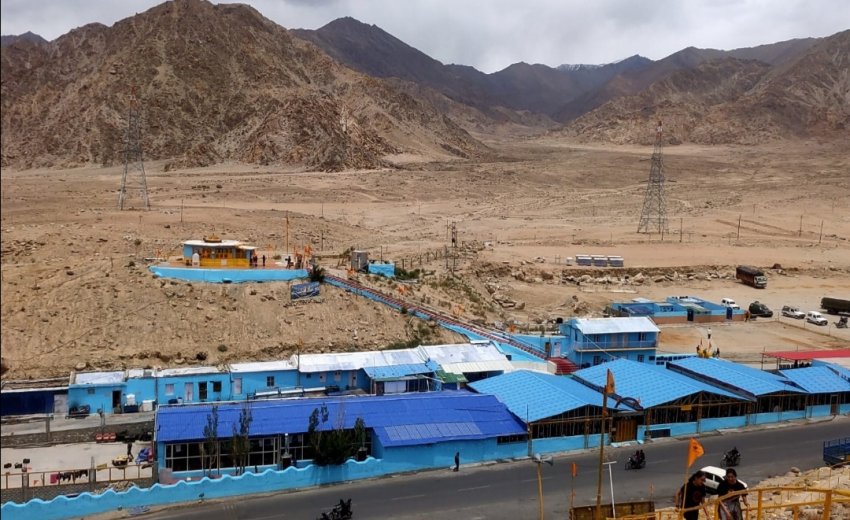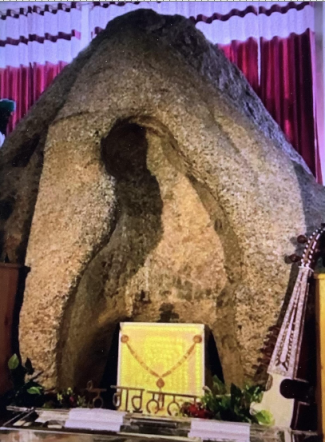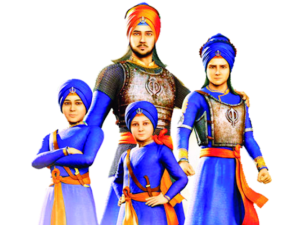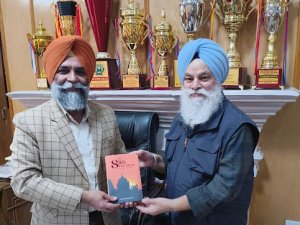Guru Nanak (1469-1539), the founder of the Sikh religion, is indeed renowned for his extensive travels during his lifetime. His journeys were characterized by profound spiritual teachings and a resolute determination to spread his message. One significant leg of his travels took him towards Sumer Parbat, a journey marked by his attire and companions. As Guru Nanak embarked on this arduous expedition, he adopted the attire of a mountaineer, wearing leather clothing and securing thick ropes around his waist. In his hand, he held an ax typically used for breaking ice while traversing mountainous terrain. Accompanying Guru Nanak were two companions, Hassu-Lohar and Sheehan Cheeban.
The path to Sumer Parbat, as described in various Janamsakhis and Vaars of Bhai Gurdas, remains somewhat shrouded in mystery, offering no concrete directions for reaching this destination. However, piecing together the available historical accounts, it is possible to speculate on the route Guru Nanak Dev Ji might have followed. His journey appears to have commenced from Kiratpur Sahib, leading him through several towns and landmarks, including Batala, Jasrota, Rwalsar, Purmandal, Bahu Fort, Jaamdev Cave (Jammu), Garabhyoni Cave (Vaishno Devi), Sheer Manjla (Udhampur), Kishtwar, Bhadarwah, Kailash mountain, Nepal, Sikkim, Tibet, Bhutan, Nankang (China), Leh Ladakh, Kargil, Skardu, Amarnath Caves,Pahalgam, Matan , Anantnag, Bejbehara, Awantipura, Hill of Shankaracharya, Chinar, Rughnath Temple, Mosque, Hari Parbat Mountain, Wular Lake,Baramulla and ultimately back to Punjab via Uri. Notably, Guru Nanak engaged with Siddhas and Yogis during his journey through the higher Himalayas, challenging their spiritual practices and urging them to consider a more selfless path to salvation.
He continued his travels through Ladakh, crossing snow-covered peaks in Pangong Lake, and journeyed along the Sindh River, passing through Chashul, Upshi, Karu, Hemus Gumpha, Leh, Nimu, Basgo, and Khalase. Guru Nanak's presence left a lasting mark, and a rock where he once sat in 'Gumpha Hemus' has been preserved in his memory.
(Gurdwara Guru Nanak Pir, Skardu)
The Guru's expedition eventually led him to Skardu, a place situated on the banks of the Sindh River. Skardu, known as "Nanak Peer di Thaan," also holds historical significance in Guru Ji's journey. Guru Ji had dialogues with Kalandar Gosh Bukhari here. In Skardu, there is a historical Gurudwara dedicated to Guru Ji but nowadays the condition is miserable. Throughout this remarkable journey, Guru Nanak Dev Ji's unwavering determination and profound spiritual insights left an indelible mark on the regions he visited, emphasizing the importance of devotion to the one Akal Purakh and advocating for a selfless approach to attaining salvation.
In Leh, Guru Ji sat on a raised stone , which still exists nearby.
The Sacred Tree known as 'Datun Sahib' (Miswak, Pelu, Arak, Salvadora- Persica, Tooth brush Tree) is a revered symbol in the Ladakh region, held in everlasting memory of Guru Nanak Dev ji, the first Sikh Guru.
Guru Ji sanctified this place with his sacred visit in the year 1517 during his third world awakening and missionary holy tour, aimed at relieving human suffering. He planted his datun (twig) here, which has since grown into a significant tree in the once treeless Ladakh desert. This tree, known as Datun Sahib, is cherished by people of all faiths, including Buddhists, Hindus and Muslims, for its sacredness and Guruji's journey to spread the message of truth, peace, and love. Recently a splendor Gurdwara has been constructed by Karsewa Babas.
A famous narrative in Basgo village passed on from generation to generation that when Guru Ji and his companions resting at this site near village Nimmu, they faced a demonic encounter. In the annals of Sikh history, there exists a profound and transformative encounter between Guru Nanak Dev Ji, the founder of Sikhism, and a malevolent demon of formidable stature. This momentous event unfolded amidst the sacred ambiance of Guru Ji's devotions, where he fervently offered his prayers, enveloped in an aura of spiritual transcendence. As Guru Ji immersed himself in prayer, fate took a sinister turn when a malevolent demon, driven by sinister intentions, unleashed a colossal boulder from a hill hurtling towards him, in a bid to extinguish the divine presence that Guru Ji embodied. Yet, what transpired next defied the laws of nature, standing as a testament to the miraculous power attributed to spiritual purity. The boulder, upon making contact with Guru Ji, underwent a profound transformation akin to wax succumbing to heat. It softened, yielding to the sanctified touch of the Guru. Astonishingly, Guru Nanak Dev Ji's form melded seamlessly into the now-pliant boulder, allowing his prayers to continue undisturbed, as though the earthly realm and the divine had harmoniously converged. Believing Guru Ji to be vanquished, the demon descended upon the site of the supernatural occurrence.
To his bewilderment and dismay, Guru Ji remained unscathed, his divine essence untouched by mortal threats. Consumed by frustration and perhaps a sense of remorse, the demon, driven by misguided anger, aimed a kick at the boulder, aiming to obliterate the perceived source of his vexation. However, the boulder once again defied all expectations, yielding to the demon's assault, as his right foot sunk into its yielding surface. Witnessing this inexplicable phenomenon, the demon's heart underwent a profound transformation. In that moment of clarity, he comprehended the sanctity and holiness of Guru Nanak Dev Ji, recognizing him as a divine disciple of God. Humbled and repentant, the demon prostrated himself at Guru Ji's feet, beseeching forgiveness for his malevolent actions. Guru Nanak Dev Ji, in his infinite compassion, opened his eyes and extended his benevolent wisdom to the transformed demon. He advised the once-malevolent entity to dedicate the remainder of his life to the selfless service of humanity. This remarkable encounter stands as a poignant testament to the transformative power of divine grace and the capacity for redemption inherent in every soul.Remarkably, this boulder still bears the indelible marks resembling Guru Ji in a meditative posture. The cavity on the rock measures approximately 9 feet in height, 8 feet in breadth, and 1.5 feet in depth. This sacred site is now known as 'Gurdwara Pathar Sahib.'Gurdwara is well-maintained by the Indian Army and Guru Ka Langar is served efficiently to the pilgrimages round the clock.
(Gurdwara Pathar Sahib Leh-Ladakh)
This itinerary took Guru Ji to the region of Kargil . At that time, the area was sparsely populated .During one night of his stay in Kargil, Guru Nanak Dev Ji observed a solitary flame of light emanating from a house. Moved by curiosity and compassion, Guruji followed the light to the source. Inside the dwelling, he discovered a person engulfed in distress and turmoil. Guru ji inquired about the cause of the man's suffering and, upon learning of his troubles, decided to halt his journey temporarily.For the next three days, Guru Ji engaged in worship and meditation at this location. During this time, the person of the house served Guruji diligently and selflessly. As a result of Guruji's spiritual guidance and blessings, the man's problems were resolved, and he found solace and purpose in following Guru Ji's teachings. Deeply touched and transformed by this divine encounter, the man dedicated his home and life to Guruji's service, becoming a devoted follower. This act of surrender and devotion led to the establishment of the "Gurdwara Charan Kamal Sahib, Patshai Paheli, Kargil " at this sacred place.
(Gurdwara Charan Kamal Sahib, Kargil)
The name signifies the place where Guru Ji's lotus-like feet brought peace and transformation to an individual's life. This journey was marked by Guru Nanak Dev Ji's tireless efforts to spread his message of compassion, equality, and the oneness of humanity. Gurdwara is maintained by the Indian Army. Guru Ji continued his journey, reaching Baltal after crossing snow-covered peaks from Kargil. From there, he ventured to the renowned Hindu pilgrimage site of Amarnath, traversing challenging mountainous and snow-covered paths and entered Kashmir Valley .
(Author with Sub.Maj Harcharan Singh )
These stories and landmarks stand as enduring testaments to Guru Nanak Dev Ji's profound impact on the Ladakh region and his mission to alleviate human suffering and promote universal values of compassion and spirituality.











